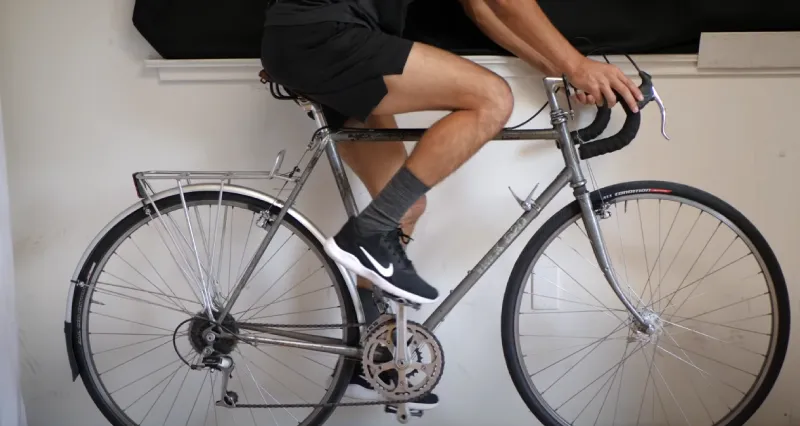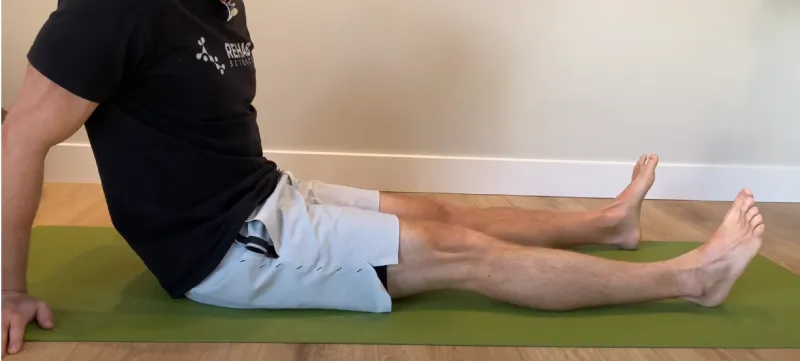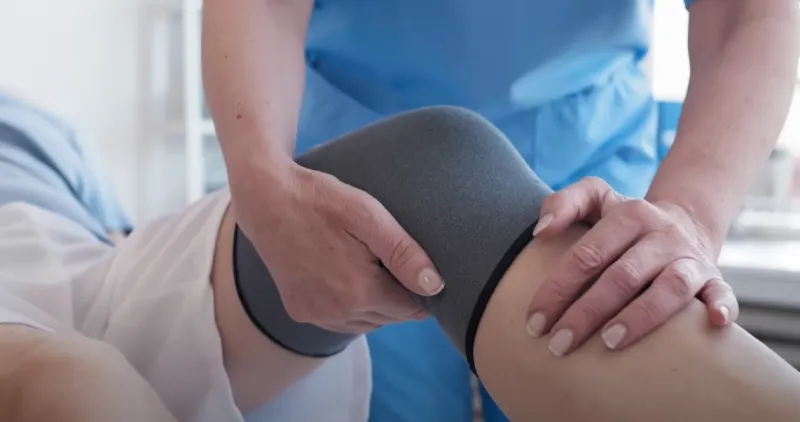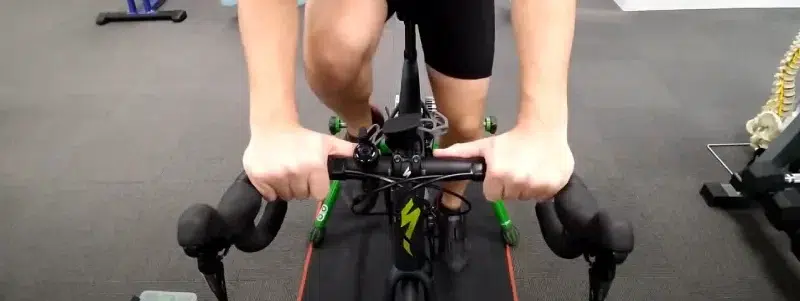Knee pain from cycling can be troublesome for cyclists, especially when managing arthritis in the knee joint.
To treat an arthritic knee as a cyclist, ensure proper bike fit to prevent pain aggravation. Strengthen quadriceps, hamstrings, and calves for added support.
Use knee sleeves for compression warmth and ice therapy, and consult a physical therapist for specialized guidance.
In this blog post, we will explore 6 different treatments with natural strategies and 4 Lifestyle Changes to treat an arthritic knee for cyclists.
How Do You Treat An Arthritic Knee For Cyclist: 4 Bike Fits

Cycling with an arthritic knee can be challenging, but with the proper adjustments and techniques, you can find relief and enjoy this fantastic activity.
Proper bike setup and cycling form are key to preventing knee pain and ensuring a comfortable ride. Discover how mastering bike fitting can significantly improve your knee health and overall cycling experience.
Cycling Techniques and Adjustments for Knee Relief
Cycling has many benefits, especially if you have knee arthritis. To ensure that cycling brings more joy than pain, you must pay close attention to how your bike is set up and how you’re cycling. Let’s explore some adjustments and techniques that can help protect your knees.
Knee Pain Relief by Bike Fitting Mastery
Getting your bike to fit you perfectly is crucial for keeping your knees happy. Here’s how you can adjust your bike for better knee health:
- Seat Height: Your seat should be adjusted so your legs are angled slightly downward during pedaling. Your knees will feel the strain if your seat is too low or too high.
- Seat Position: Move your seat forward or backward so that when your pedal is at 3 o’clock, your knee is directly over your foot. This alignment helps reduce unnecessary pressure on your knees.
- Handlebar Height: Adjust your handlebars so you can ride comfortably without leaning too far forward or sitting too upright. The right position helps distribute your weight evenly and reduces knee stress.
Pedal Power: Techniques and Gear Shifts That Protect Your Knees
How you pedal and use your gears can also impact your knee health. Here are some techniques to keep in mind:
- Smooth Pedaling: Aim for a smooth, circular pedaling motion rather than pushing down hard on the pedals. This technique helps disperse the force and reduces pressure on your knees.
- Use Your Gears: Don’t stick to a single gear. Shift gears to maintain a steady, comfortable cadence, especially on hills. Putting too much force on your pedals in a high gear can strain your knees.
- Cadence Matters: Keep your cadence (how fast you pedal) between 80 to 100 revolutions per minute. Pedaling at a faster cadence in a lower gear is easier on your knees than a slow, forceful pedaling in a higher gear.
Strength and Flexibility: Exercises to Support Your Knees
Building strength and flexibility is like giving your knees a suit of armor and the agility of a cat. Here’s what you can do:
Leg Strengthening Exercises

Focus on exercises that build the muscles around your knees. Squats and lunges are great, but keep them shallow to avoid strain. Leg presses and hamstring curls on machines are also beneficial.
- Start with light weights and increase gradually.
- Aim for 2 to 3 times a week.
- Flexibility Workouts: Stretching keeps your muscles long and limber, reducing pressure on your knees.
- Include stretches for your hamstrings, quads, and calves in your routine.
- Yoga or Pilates can be excellent for overall flexibility and strength.
The Role of Cross-Training: Mixing It Up for Knee Health
Only cycling can put a repetitive strain on your knees. Mixing up your activities can help:
- Swimming: This fantastic low-impact exercise gives your legs a workout without putting pressure on your knees.
- Walking: Believe it or not, regular walking can strengthen your legs and improve joint health, as long as you wear supportive shoes and stick to flat surfaces.
- Elliptical Trainer: An elliptical provides a good cardio workout while mimicking the cycling motion without the strain.
Cyclists’ Arthritis Knee Medical Treatment And Therapies
If you’re a cyclist dealing with knee arthritis, navigating through the myriad of medical treatments and therapies can feel overwhelming. But fear not! We’re here to guide you down this “Medical Alley” with clear advice on what works, from over-the-counter remedies to the latest medical advancements.
OTC and Prescription Solutions for Finding Relief
To help with pain and inflammation in arthritic knees, you can choose from various readily available options or can be prescribed by your doctor. Here’s what you need to know:
Pain Relievers: Over-the-counter options like ibuprofen, Naproxen, or acetaminophen can help reduce pain. It’s important to use them as directed to avoid side effects.
- Always follow the recommended dosage.
- Consider talking to your doctor about what’s best for you.
Topical Creams: Creams that you rub on your knees can provide relief. Several topical products are made with diclofenac, a nonsteroidal anti-inflammatory medicine. They treat osteoarthritis in cyclist knee joints that are close to the skin.
- Look for creams with ingredients like capsaicin or menthol.
Prescription Medications: If over-the-counter options aren’t enough, your doctor might prescribe stronger medications. These can include anti-inflammatory drugs or corticosteroids.
- It is essential to consult a physician about potential side effects.
Cutting-Edge Treatments: Exploring Advanced Options
For those seeking more than traditional treatments, the medical field offers some exciting advanced therapies that could provide significant relief:
PRP Injections: Platelet-rich plasma (PRP) therapy involves injecting components from your blood into the knee to promote healing. It’s gaining popularity for its potential to relieve pain and improve function without surgery.
- Multiple sessions may be required to complete the procedure.
Stem Cell Therapy: This involves using stem cells (often taken from your body) to help repair damaged tissues in the knee. While still considered experimental for knee arthritis, early results are promising.
- Research is ongoing, so talk to a specialist knowledgeable about the latest findings.
Hyaluronic Acid Injections: “gel injections” can lubricate the knee joint, making movement smoother and less painful.
- This treatment may not work for everyone, but it’s worth discussing with your doctor.
Treat An Arthritic Knee For Cyclist: 3 Natural Strategies

Dealing with an arthritic knee can make cycling less enjoyable. But there are natural ways to manage pain that don’t involve medicine. Let’s explore some methods you might find helpful.
Heating Pads: Warm Relief for Arthritic Knees
A heating pad can be a simple yet effective way to ease the pain in your arthritic knee.
When to Use a Heating Pad: It is best used before you cycle to make your knee joints more flexible. It can also comfort you after a ride if your knees feel stiff.
Benefits:
- It helps relax and loosen tissues, making movement easier.
- Increases blood flow to the knee, which can help with healing.
Precautions:
- Don’t use it for too long; 20 minutes is usually enough.
- Make sure it’s not too hot to avoid burns.
- If your knee is swollen or bruised, it’s better to use ice instead.
Ice Therapy: Cooling Down Knee Pain
This method, known as cold therapy, has some cool benefits that help the arthritic knee recover. The debate between using ice or heat for knee arthritis can be confusing. Here’s when and how to use ice effectively.
How Long to Ice Your Arthritic Knee:
- Aim for about 15-20 minutes per session. More than that might do more harm than good.
Best Practices:
- To protect your skin, wrap the ice pack in a thin towel.
- It’s great for reducing swelling, especially after a long ride.
- Avoid using ice just before cycling, as it can stiffen the joint.
Magnesium Supplements: A Mineral Boost for Knee Health
Magnesium is key in managing arthritic knee pain, and here’s why.
Benefits of Magnesium:
- Muscles and nerves are maintained by it.
- It can reduce inflammation in the knee.
Recommended Daily Intake and Sources:
- Adults should aim for about 320 mg (women) to 420 mg (men) daily.
- Natural sources of magnesium such as spinach, nuts, and whole grains. If needed, consult your doctor before considering a magnesium supplement.
Manage Arthritis Knee Pain In Cyclists: 4 Lifestyle Changes
When you love cycling but struggle with arthritic knee pain, every pedal stroke can feel like a challenge. Beyond the bike, several strategies exist to manage your pain and keep doing what you love. Here’s how to adjust your daily life to help ease that discomfort.
Sleeping Tips: Finding Comfort Through the Night

Sleep is essential to healing, but arthritic knee pain can make it hard to find a comfortable position.
- Positioning: Try sleeping on your back or side. Don’t put the painful knee on the bottom if you’re a side sleeper.
- Pillow Support: If you sleep on your side, place a pillow between your knees or under your knees if you sleep on your back. This helps keep your knees in a gentle, supported bend that can reduce pain.
Post-Cycling Care: Embracing Rest and Recovery
After a ride, it’s essential to give your body the time it needs to recover, especially your knees.
- Cool Down: Finish your rides with a slow, gentle cool-down period.
- Stretch: Incorporate stretches that focus on your legs and lower back to keep your muscles flexible and reduce strain on your knees.
Nutrition for Joint Health: Fueling Stronger Knees
What you eat can impact your joint health. Inflammation can be reduced, and specific foods can support knee health.
- Omega-3 Fatty Acids: Fish like salmon and flaxseeds are substantial sources of omega-3 fatty acids, which can help reduce joint inflammation.
- Vitamin C: Consuming vitamin C-rich foods can maintain healthy knee cartilage.
- Calcium and Vitamin D: Important for bone health, found in dairy products, leafy greens, and fortified foods.
Weight Management: Lightening Knee Load
Gaining weight puts an additional strain on your knees. Keeping your weight in check can ease the pressure and pain in your arthritic knees.
- Balanced Diet: Focus on whole grains, a diet rich in fruits, vegetables, and lean proteins.
- Regular Exercise: Combine cycling with low-impact activities and strength training to manage your weight without putting extra stress on your knees.
- Avoid High-Impact Activities: Choose low-impact exercises like swimming or using an elliptical machine over running or jumping.
Conclusion
Road warriors and mountain cyclists, we’ve managed knee arthritic while fueling our cycling passion. A smoother ride involves bike adjustments, therapies, adaptability, and resilience.
Knee arthritis may challenge us, but we can relish the freedom and joy of cycling with the right mindset. Stay motivated, explore what suits your body best, and always remember why you fell in love with cycling.
Our journey ahead is full of opportunities to adapt, conquer, and progress. Let’s ride into the future with determination, passion, and a smile, knowing our best cycling days are ahead, arthritis or not. Keep spinning.
FAQs
How Long Does Arthritis In The Knee Last?
There is no cure for knee arthritis, which is a lifelong condition. But the good news is that treatment can relieve some symptoms and slow down or stop the disease from worsening.


